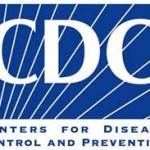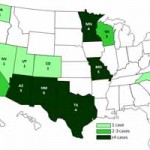The Centers for Disease Control and Prevention has issued a press release detailing how people can help detect and solve food poisoning outbreaks. Every year, about 1 in 6 Americans (48,000,000 people) get sick from a foodborne illness. While most of these cases are individual, some are part of larger outbreaks. If a large number of people are sick in a given period and area, it's called a cluster. A cluster is an outbreak when investigations reveal that the bacteria that made them sick is the same. The CDC uses epidemiologic, traceback, and environmental investigations to help solve these outbreaks. Finding the source of the outbreaks is critical to ending it and to make sure that more people don't get sick. There are currently several active multistate foodborne illness … [Read more...]
PulseNet Prevents 276,000 Food Poisoning Cases a Year
PulseNet, a network coordinated by the Centers for Disease Control and Prevention (CDC) has prevented about 276,000 cases of food poisoning in the U.S. every year, according to new research published in the American Journal of Preventive Medicine. Every time there is an outbreak, we mention this organization, which matches DNA of pathogenic bacteria to any illnesses in its database. PulseNet began 20 years ago, linking public health labs in this country so details about E. coli, Salmonella, Campylobacter, and Listeria monocytogenes outbreaks can be shared quickly. The illnesses this organization has prevented could have cost the U.S. $507 million in medical bills and lost productivity. The study was conducted by Dr. Robert L. Scharff, Dr. John Besser, Dr. Donald Sharp, Dr. Timothy F. … [Read more...]
USDA Finalizes Ground Meat Safety Rule
The USDA's Food Safety and Inspection Service (FSIS) announced today that it has finalized a rule to ensure that retailers can track sources of ground meats. Those products are often recalled and linked to food poisoning outbreaks. FSIS is requiring that all makers of raw ground beef products keep records of the source material so the agency can work with suppliers to recall contaminated products. Ground beef is often made with beef cuts that come from various sources. That increases the likelihood that contaminated meat will further contaminate a large amount of ground beef, and it makes the government's work on tracing suppliers much more difficult. When stores make ground beef by combining beef from different sources and do not keep clear records, recalls become more … [Read more...]
FDA Finalizes FSMA Rules on Produce Safety
The FDA finally finalized the rules on produce safety last week. Michael Taylor, the head of that agency said in a statement, "Its been a long and arduous task, to say the least. Finalizing the rules is just one part of building a modernized food safety system." The Food Safety Modernization Act was passed in 2011. The major rules in that Act have been slowly finalized by the FDA and the Office of Management and Budget. This latest new rule targets produce grows. They must ensure the safety of water in irrigation, since some outbreaks have been caused by produce contaminated by irrigation water that contains Salmonella or E. coli bacteria. They must make sure workers practice good hygiene in the field and while packing. A Cyclospora outbreak linked to imported cilantro lead to a ban … [Read more...]
CDC Releases Report on Multistate Food Poisoning Outbreaks
The Centers for Disease Control and Prevention (CDC) has released a report titled "Safer Food Saves Lives." In it, they state that more multistate food poisoning outbreaks are being discovered and reported. Those outbreaks are very serious, even though individual food poisoning cases are more common. In fact, multistate outbreaks caused 56% of all deaths in all reported foodborne outbreaks, even though they accounted for just 3% of all outbreaks from 2010 to 2014. In other words, while multistate food poisoning outbreaks are not common, they are more deadly. That's because the bacteria Salmonella, E. coli, and Listeria monocytogenes cause 91% of multistate outbreaks. Those bacteria can cause serious illness, severe complications such as hemolytic uremic syndrome, and are deadly. On … [Read more...]
FDA: Food Poisoning Outbreaks Are Increasing
Food poisoning outbreaks are on the rise, according to the U.S Food and Drug Administration (FDA). And their scope can be be much larger today than ever before. Better detection is one reason for the increase in the number of outbreaks reported annually, but another is the globalization of the food supply, the agency said in report it put together for Public Health Week. In the report, the agency describes how it does its job and the challenges it faces. Because of the way our system getting food from farm to table has changed, outbreaks can happen in widely separated areas making them difficult to detect. In the caramel apple Listeria outbreak, for example, 35 cases were reported from 12 states- a block of seven states sharing borders in the Southwest: Arizona, California, … [Read more...]
Vilsack Commits to Exempting Mechanically Tenderized Beef Regulation
According to Congresswoman Rosa DeLauro (D-CT), USDA Secretary Tom Vilsack said last week in a congressional hearing that he may suspend the Uniform Labeling Regulation so that the rule for labeling mechanically tenderized beef (MTB) products can be issued. Mechanically tenderized beef is whole cuts of beef that have been pierced with fine blades or needles to break up the connective tissue in the meat. This action introduces bacteria to the interior of the cut, and poses a food safety hazard if the meat is not cooked to 160°F. The MTB labeling rule has been pending for 10 years. Meanwhile, there have been food poisoning outbreaks linked to this product. Two outbreaks, one in 2003 and the other in 2009, caused 174 illnesses and killed one person. And remember that these numbers are only … [Read more...]
Research Shows How E. coli O157:H7 Binds to Produce
New research presented at the Society for General Microbiology's Annual Meeting showed how E. coli O157:H7 binds with plant cells. This lets the bacterium hold on to the plant's surface so it can multiply. And that means that washing produce is not going to easily remove this pathogenic bacteria. Between 20 to 30% of food poisoning outbreaks are linked to contaminated vegetables. Researchers from the James Hutton Institute in Scotland found that E. coli O157:H7 uses flagella, which are thin appendages usually used for movement, to penetrate the plant cell walls. The flagella interacts with fat molecules in the plant cell membranes. Once they are attached, the E. coli bacteria colonize the plant's surface. Most of the bacteria can be removed by washing at this point, but some can … [Read more...]
Consumers Can Help Solve Food Poisoning Outbreaks
Have you ever wondered how food poisoning outbreaks are solved? Consumers play a key role, according to the Centers for Disease Control and Prevention (CDC). Here's how you can help. When you are sick follow these steps. You may help solve the next food poisoning outbreak. Contact the health department. If you think you have food poisoning, contact your local or state health department and let them know. When public health officials can track clusters of people with similar symptoms and exposures, it helps them to identify potential outbreaks. See your doctor. Your doctor can order stool samples and blood tests that can determine if you have an infection from E.coli, Salmonella, Campylobacter, Listeria or other foodborne bacteria. A Pulsed-field Electrophoresis test determines the … [Read more...]
The Largest Multi-State Food Poisoning Outbreaks of 2013
The 11 largest multi-state food poisoning outbreaks of 2013 sickened 1,642 people in 48 states and Puerto Rico. Nine of the outbreaks were caused by food contaminated with bacteria: five from Salmonella, two from E.coli , and one each from Listeria and Vibrio. The other two outbreaks were caused by a virus, hepatitis A and a parasite, Cyclospora. The food sources of these outbreaks included ground beef, frozen berries, salad mix served at restaurants, chicken, cilantro, cucumbers, tahini paste, cheese, raw shellfish, frozen snack foods and prepared salads. Four of the outbreaks were caused by imported foods: Cyclospora from salad greens and cilantro imported from Mexico; Hepatitis A from a frozen berry mix containing contaminated pomegranate seeds imported from Turkey; a Salmonella … [Read more...]














